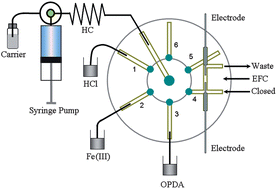The miniaturized lab-on-valve (LOV) manifold well hyphenated with indirect biamperometry is presented for automated determination of trace level concentrations of organic environmental pollutants by programmable flow. The experimental procedure was carried out by means of taking o-phenylenediamine (OPDA) as a model analyte, relying on the Fe(III)/Fe(II) couple that served as an indicating redox system. The miniaturized electrochemical flow cell (EFC) designed and processed was integrated into the LOV module which is assembled with two identical polarized platinum electrodes between which a small potential difference (ΔE) was applied, to implement automated on-line analysis in a closed system. Factors affecting analytical performance are discussed, including indicating redox systems, concentration of indicating system, the acidity, the potential difference, and flow variables in the LOV. The calibration curve showed an excellent linearity in the concentration range of 5.0 × 10−7 to 1.0 × 10−4 mol L−1 (R2 = 0.9993). The limits of detection (LOD) and quantitation (LOQ) for OPDA were found to be 1.1 × 10−7 and 3.7 × 10−7 mol L−1, respectively. A sampling frequency of 40 h−1 was obtained along with an R.S.D. of 2.8% at 1.0 × 10−6 mol L−1OPDA (n = 11). The proposed procedure was successfully applied to the assay of OPDA in industrial waste water.

You have access to this article
 Please wait while we load your content...
Something went wrong. Try again?
Please wait while we load your content...
Something went wrong. Try again?


 Please wait while we load your content...
Please wait while we load your content...